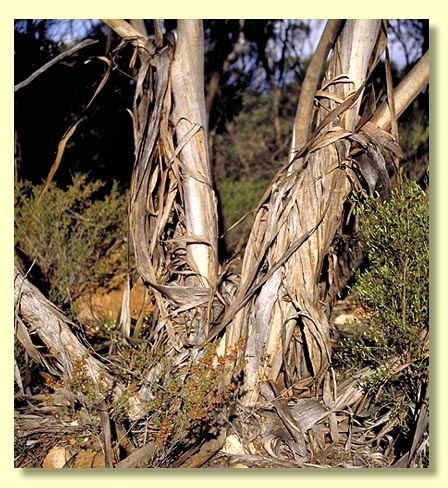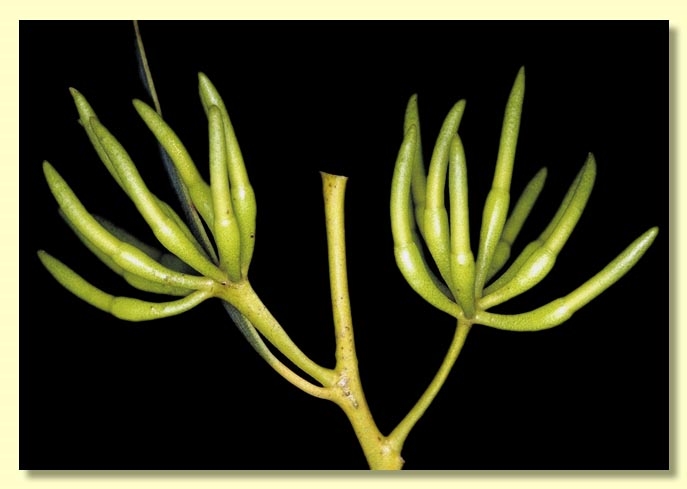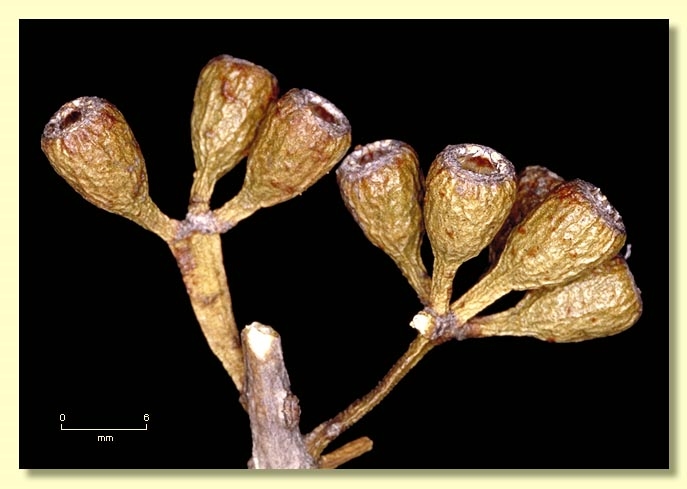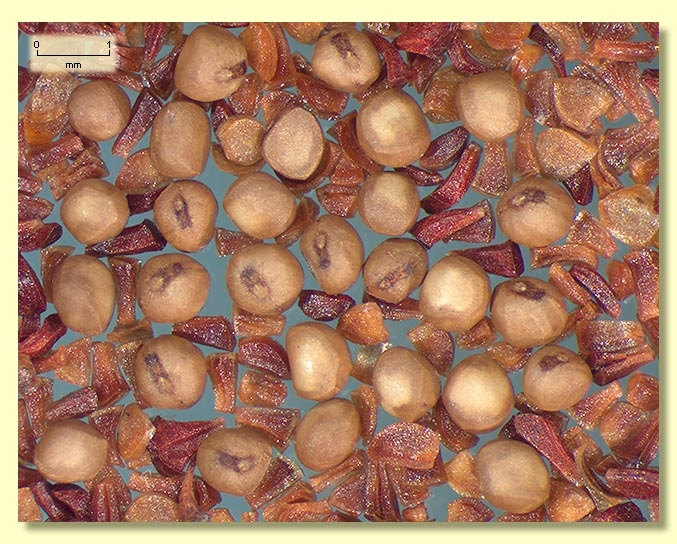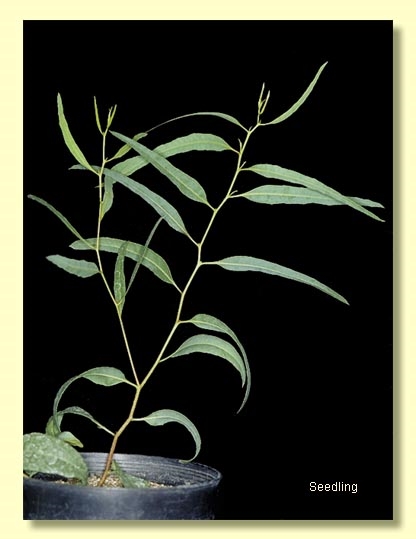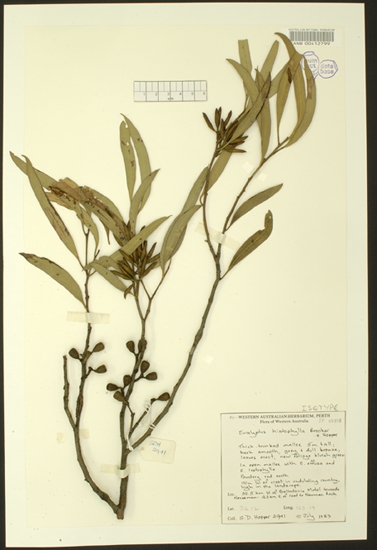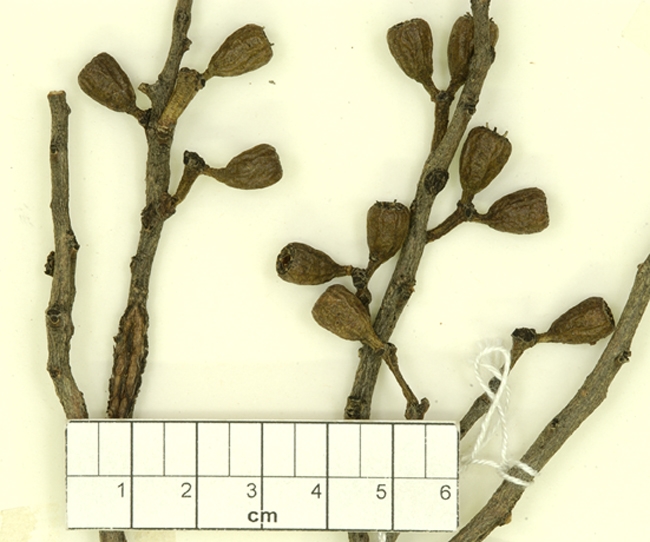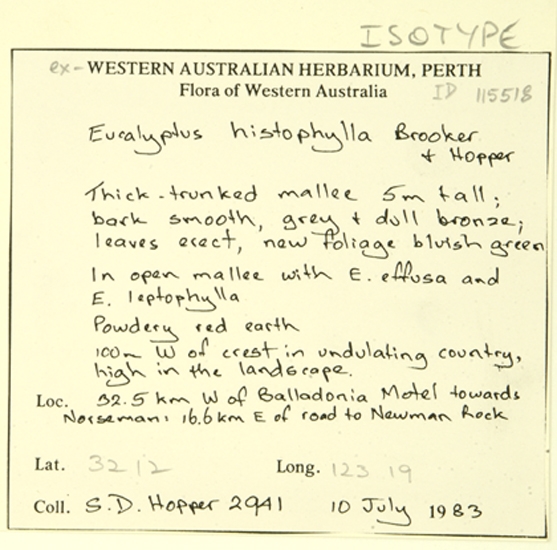Eucalyptus | Symphyomyrtus | Bisectae | Glandulosae | Levispermae | Phaenophylla
Euclid - Online edition
Eucalyptus histophylla
Bark smooth throughout but with conspicuous ribbons of shed bark, light grey, dark grey and pale pinkish brown.
Branchlets with sparsely glandular pith.
Juvenile growth (coppice or field seedlings to 50 cm): from Brooker & Hopper (1991): juvenile leaves opposite for 2 or 3 of pairs then alternate, ovate to lanceolate to 11 cm long, to 4 cm wide, glossy green, glabrous.
Adult leaves alternate, petioles 0.8–1.8 cm long, held erect; blade linear to narrowly lanceolate, 6.5–12.5 cm long, 0.6–1.6 cm wide, base tapering to petiole, margin entire, apex pointed, concolorous, dull, blue-green but maturing glossy, green, side-veins acute, reticulation sparse to moderate, intramarginal vein more or less close to margin, oil glands numerous and mostly island.
Inflorescence axillary unbranched, peduncles widening apically, 0.8–2 cm long, buds ?11 per umbel, pedicellate (pedicels 0.2–0.4 cm long). Mature buds long-fusiform (2–3 cm long, 0.35–0.4 cm wide), scar present, operculum horn-shaped, twice to three times the length of the hypanthium and equal to it in width at the join, few outer stamens erect, most stamens variably deflexed, anthers oblong, versatile, dorsifixed, dehiscing by longitudinal slits, style long and straight, stigma rounded to tapered, locules 3, the placentae each with 4 vertical rows of ovules. Flowers pale yellow.
Fruit pedicellate (pedicels 0.3 cm long), cylindrical to barrel-shaped or obconical, 0.8–1.1 cm long, 0.5–0.7 cm wide, disc descending vertically, valves 3, near rim level.
Seeds pale brown to straw-coloured, 0.8–1.8 mm long, sub-spherical, surface smooth, hilum ventral/terminal.
Cultivated seedlings (measured at ca node 10): cotyledons Y-shaped (bisected); stems rounded in cross-section; leaves always petiolate, opposite for 2 to 4 nodes then alternate, lanceolate, 7–11 cm long, 1–2 cm wide, dull to slightly glossy, mid-green, margin slightly scabrid.
Flowering has been recorded in December.
A mallee or small tree endemic to Western Australia, found mainly from between the Fraser Range and Balladonia, also south to Mt Buraminya, on areas of outcropping granite, with an westerly extension to the fringe of the wheatbelt where it occurs on laterite. The bark is smooth, adult leaves slightly glossy, green, held erect in the crown, and the buds elongated-fusiform.
Eucalyptus histophylla belongs to Eucalyptus subgenus Symphyomyrtus section Bisectae subsection Glandulosae because the cotyledons are bisected, buds have an operculum scar and the branchlets have oil glands in the pith. Within this subsection E. histophylla is one of a group of species that form series Levispermae subseries Phaenophylla characterised by having smooth sub-spherical seed, a peduncle that widens apically, buds that are narrowly fusiform with some stamens erect and others variably deflexed, and glossy green adult leaves.
E. histophylla is distinguished from its near relatives by the erect linear to narrowly lanceolate adult leaves and slender buds (2 to 3 cm long) that have the operculum equal in width to the hypanthium at the join. All the related species have spreading adult leaves. Both E. arachnaea and E. phaenophylla subsp. phaenophylla have buds contracted where the operculum joins the hypanthium. Both E. phaenophylla subsp. interjacens and E. tumida have fatter buds and broader leaves. To the north of the distribution of E. histophylla is another desert-dwelling related species, E. flavida, also a mallee with glossy green adult leaves, differing in often having some rough bark at the base of stems and leaves not held erect in the crown.


